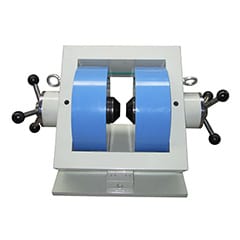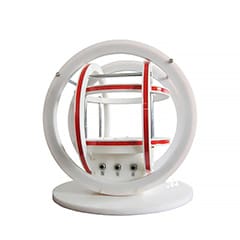products categories
contact us
- If you have questions, please contact us, all questions will be answered
- Tel : 18030236818
- Fax : +86-592 5237901
- Email : dexing@china-dexing.com
Hall Effect Measurement System
What is a Helmholtz resonator?
In Helmholtz's book On the Perception of Tone, the original design of the Helmholtz resonator was a brass container, spherical in shape, with a small neck with a mouth at one end and a large hole for a radio port at the other end (see figure 1). The most common modern Helmholtz resonator is a funnel-shaped hollow glass sphere with an exit port at one end, as shown in Fig. 2 (a) [2]. In addition, there are a variety of shapes. In Figure 2 (b), there is only a small opening in the ball, and in Figure 2 (c), there is an additional listening hole at the bottom of the ball, which is similar to the original design. When Helmholtz measured the compound sound, he pointed the speaking port at the ear and the receiver port of the resonator at the sound source. When a certain overtone in the sound source was the same as the natural frequency of the resonator, the resonator would appear resonance phenomenon
In Helmholtz's book On the Perception of Tone, the original design of the Helmholtz resonator was a brass container, spherical in shape, with a small neck with a mouth at one end and a large hole for a radio port at the other end (see figure 1). The most common modern Helmholtz resonator is a funnel-shaped hollow glass sphere with an exit port at one end, as shown in Fig. 2 (a) [2]. In addition, there are a variety of shapes. In Figure 2 (b), there is only a small opening in the ball, and in Figure 2 (c), there is an additional listening hole at the bottom of the ball, which is similar to the original design. When Helmholtz measured the compound sound, he pointed the speaking port at the ear and the receiver port of the resonator at the sound source. When a certain overtone in the sound source was the same as the natural frequency of the resonator, the resonator would appear resonance phenomenon
Antimulator (resonant sound absorption)
Principle of resonant sound absorption structure
Sound absorption, mainly refers to the energy consumption process of sound wave in the propagation process of medium. When sound waves travel to the surface of the medium, part of the sound waves will be reflected back, the other part is absorbed by the medium, converted to mechanical energy transfer or converted to thermal energy consumption. The phenomenon of sound absorption is universal, but only the material with strong sound absorption ability can be used in practical occasions. There are two principles of sound-absorbing materials. One is to convert sound energy into heat energy through material friction. The other is to convert sound energy into mechanical energy (vibration) and then into heat energy through material vibration.
Helmholtz resonators are resonant sound absorbing structures. Inside the structure is a resonant cavity and a spring system (see Figure 3). The resonant cavity is connected with the outside by opening a neck, and the sound waves enter the cavity through the neck, making the air in the neck move back and forth to compress the air in the cavity, forming an air spring. When the frequency of the incident sound wave is consistent with the natural frequency of the resonator structure, the resonance amplitude is the largest and the energy consumed is the largest. Therefore, the resonant sound absorption structure has a strong selectivity to the sound absorption frequency, and the sound absorption effect is generally better in the middle and low frequency.
Resonator actual function and improvement
In practical applications, multiple parallel resonant sound absorption structures are often used together, or combined with other sound absorption materials to broaden the sound absorption bandwidth and improve the performance of sound absorption. For example, resonant sound-absorbing brick (see figure 4) has the advantages of sound insulation, heat preservation, simple sound-absorbing structure and low price.
Some scholars have studied the improvement of Helmholtz resonators, such as changing the length of the connecting pipe and the number of series and parallel resonators without changing the size of the resonator, which will effectively improve the acoustic characteristics of the resonant frequency. Firstly, the resonator is divided into resonant tube and resonant cavity, and the influence of the length of the tube and the shape of the tube cross section on the resonator is discussed. Multiple resonators are connected in series or in parallel to discuss the changes of acoustic characteristics such as muffling frequency band and formant. Some scholars found that the outer neck of the Helmholtz resonator is changed into the inner neck, so that the sound absorption structure with the same acoustic characteristics can be obtained, and the thickness of the sound absorption structure can be thinned.
If the socket neck is bent, the thickness of the sound absorbing structure can be further reduced.
Some scholars studied "the influence of sound absorbing materials on the sound absorption performance of Helmholtz resonator" [3]. The study showed that, after adding sound absorbing materials, the resonance frequency of Helmholtz resonator was inversely proportional to the thickness of the material, and the transmission loss was inversely proportional to the thickness of the material. When the thickness of the resonant device material remains unchanged and the flow resistance continues to increase, the resonant frequency will first decrease and then increase until the flow resistance reaches infinity. The sound-absorbing material can be regarded as a rigid wall, and the volume of the cavity changes, resulting in the change of the resonant frequency.
Some scholars use the Helmholtz resonator to absorb the noise to study the feasibility of noise generation. The research shows that the resonance cavity resonates with the sound wave, so that the energy of the sound wave is concentrated. The vibration diaphragm is installed in the neck and connected with the electromagnetic generator oscillator. The magnetic induction line is cut to convert the mechanical energy of the vibration of the diaphragm into electric energy.
2 AUDIBLE DEVICE
To improve the sound field
Famous acousticist Ma Dayou pointed out that the Helmholtz resonator can control the sound quality of the hall. For example, in the Festival Hall in London, the low frequency reverberation time is short, resulting in poor sound. Put the microphone into multiple resonators to receive part of the frequency sound, and then amplify and feedback it to the hall, which can extend the reverberation time of 100 Hz~700 Hz, and make the performance timbre more rich.
In the same way, Helmholtz resonators are placed in the theater in the form of urns and bottles, which can modify sound. For example, in the 5th century BC, the ancient Greeks used brass bottles to harmonize theater sounds. According to Ma Dayou, "the use of ceramic urns as resonators under the stage or on the walls to ampliate or absorb sound is a commonly used sound quality control technology in the past dynasties" [5]. Helmholtz resonator can be excited by the external sound field and consume its energy, but the vibration in the cavity can enhance the external sound field by radiating sound waves through the short tube. In ancient China, there was also a practice of burying empty cans in cinemas to enhance the singing effect. In the book Mozi, a device used to amplify the sound of the enemy's activities with a large urn buried underground (also used in tunnels during the Anti-Japanese War) [6].
Some scholars have studied the influence of urns on the acoustic field of buildings. Taking the ancient stage of Longtian Temple in Shanxi Province as an example (see Figure 5) [7], they measured the data of the urns in the stage, the natural frequency of individual urns and the acoustic characteristics of combined urns. In the measurement of individual ceramic urns, it is found that the resonance phenomenon can occur in different frequency bands for different sizes of ceramic urns. It is found that the interval relationship composed of the natural frequency of the pottery urn is closely related to the mode of Puju which is often performed in the local area. If Puju is sung on the stage, the pottery urn will amplify the sound. Scholars analysis, because the ceramic urn is inlaid in the side wall, and the height from the ground is parallel to the height of the actor's mouth, can ensure the sound incident sound wave straight
Instrument design
Violin is a stringed musical instrument, the sound process is very complex. First of all, the string vibration is generated when the bow is grazed by the string, and the string vibration is transmitted to the panel through the horse. The vibration of the panel amplifies the sound and produces rich harmonics at the same time. Finally, it is transmitted to the F hole of the sound box so that the sound is transmitted out. Without an F hole, the violin is low in volume and dull in tone. Among them, the F hole on the panel of the sound box makes the whole sound box form a Helmholtz resonator, which can not only let out all the sounds, but also strengthen the sound of the last octave of the instrument. "According to simple acoustics, this enhancement reaches zero at the lower half octave of the resonance, near # C-D on the G-string of the violin" [8].
The hand disc is an instrument based on the Helmholtz resonator principle (see figure 6). The hand disc is composed of two hemispherical shaped nitriding steel die, which has strong toughness. The central point of the hand disc is the basic sound "Ding". Around the central point, there are 8 depressions, which can produce different pitches, arranged in the Z character from the lowest to the highest. There is a hole in the center of the bottom, called the "Gu", which serves as a bass part and also acts as a tuner, causing the air inside the disc to flow and resonate.
In the process of making the hand disc, each note will be adjusted by countless beats. The resonant cavity of the hand disc is in its interior, and each disc has a fixed mode. With continuous percussion, the rigid wall may become thinner so that the pitch is not accurate. Therefore, producers need to continue to explore in the design of the instrument shape and musical performance.
Reverse phase loudspeaker design
Inverse phase type loudspeaker is a kind of loudspeaker that applies more widely at present, different with closed type loudspeaker, it has inverted phase tube installed on the panel of box body (among them "phase" is the phase that points to sound wave). Loudspeaker driven by diaphragm air vibration voice, to the body to the casing outside the transmission and transmission of sound waves opposite phase (such as diaphragm outward movement, the outside air is squeezing become dense, the inside of the thin air), inverting tube can be spread to the acoustic radiation to the front, making it the same as the original speaker outward radiation sound wave phase, This can increase the energy of sound waves. The higher the frequency of sound wave, the faster the attenuation, the shorter the wavelength of medium and high frequency sound wave, the sound wave radiated by the loudspeaker is easy to be absorbed by the box body, therefore, the design of inverting loudspeaker has a certain effect on improving the low frequency response.
3 summary
In addition to the article, the common life conch, ocarina, African drum, car exhaust device, etc., are equivalent to Helmholtz resonators, which can be classified into two applications, the sound absorption of energy consumption of the sound field and the sound enhancement of the sound field. Although the Helmholtz resonator has experienced more than 100 years of development, it is still being used in new fields and deserves more research by scholars.











